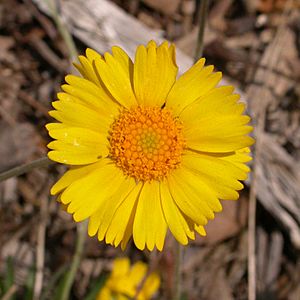Angelita daisy facts for kids
Quick facts for kids Angelita daisy |
|
|---|---|
 |
|
| Conservation status | |
| Scientific classification | |
| Kingdom: | |
| (unranked): | |
| (unranked): | |
| (unranked): | |
| Order: | |
| Family: | |
| Genus: |
Tetraneuris
|
| Species: |
T. acaulis
|
| Binomial name | |
| Tetraneuris acaulis (Pursh) Greene 1898
|
|
| Synonyms | |
|
Synonymy
Gaillardia acaulis Pursh 1813
Actinea acaulis (Pursh) Spreng. Actinella acaulis (Pursh) Nutt. Cephalophora acaulis (Pursh) DC. Hymenoxys acaulis (Pursh) K.F. Parker Picradenia acaulis (Pursh) Britton Ptilepida acaulis (Pursh) Britton Actinea eradiata (A.Nelson) A.Nelson Actinea incana (A.Nelson) A.Nelson Actinea osterhoutii A.Nelson Actinea simplex (A.Nelson) A.Nelson Actinella eradiata (A.Nelson) A.Nelson Actinella incana (A.Nelson) A.Nelson Actinella simplex (A.Nelson) A.Nelson Tetraneuris eradiata A.Nelson Tetraneuris incana A.Nelson Tetraneuris pygmaea (A.Gray) Wooton & Standl. Tetraneuris septentrionalis Rydb. Tetraneuris simplex A.Nelson Actinea arizonica (Greene) A.Nelson Tetraneuris arizonica Greene Actinea argentea (A.Gray) Kuntze Actinea formosa (Greene ex Wooton & Standl.) A.Nelson Actinea leptoclada (A.Gray) Kuntze Actinella leptoclada A.Gray Actinea lanigera Daniels Tetraneuris brevifolia Greene Tetraneuris lanata Greene Tetraneuris lanigera Daniels Actinea epunctata (A.Nelson) A.Nelson Actinella epunctata (A.Nelson) A.Nelson Tetraneuris crandallii Rydb. Tetraneuris epunctata A.Nelson |
|
Tetraneuris acaulis is a type of flowering plant. It belongs to the sunflower family. You can find it growing in North America.
This plant has a few common names. People sometimes call it the angelita daisy. Other names include stemless four-nerve daisy and butte marigold. It's also known as stemless rubberweed.
Where it Grows
Tetraneuris acaulis grows in many places. It is found across the western and central United States. You can also see it in west-central Canada. This includes the provinces of Alberta and Saskatchewan. It also grows in northern Mexico. There, it is found in states like Chihuahua and Coahuila.
This plant likes to grow in different types of areas. It can be found in foothills and subalpine regions. These are areas just below the tree line in mountains. It also grows in high prairies, badlands, and flat plains.
What it Looks Like
Tetraneuris acaulis is a very changeable plant. It is a perennial herb. This means it lives for more than two years. It can be very tiny or grow over 60 centimeters (about 2 feet) tall.
The plant has upright stems. Its leaves grow in a cluster at the bottom of the plant. These leaves can be smooth or hairy. They might also have special glands.
Each plant can have a few or many flower heads. These heads grow one by one on hairy stalks. The bottom part of each flower head can be up to 1.6 centimeters (0.64 inches) wide. Each head has 8 to 21 yellow ray florets. These look like petals and can be up to 2 centimeters (0.8 inch) long. In the middle, there are many small yellow disc florets. Sometimes there are 200 or more of these tiny flowers.
After flowering, the plant produces small, dry fruits. These are called achenes. They are only a few millimeters long. Tetraneuris acaulis usually blooms in the summer.
Different Types
Scientists generally agree that there are five main types, or varieties, of this plant. Each variety might have slightly different features. They also tend to grow in specific areas.
- Tetraneuris acaulis var. acaulis is found in Canada and many US states. These include Colorado, Montana, and Texas. It also grows in parts of Mexico.
- Tetraneuris acaulis var. arizonica grows in states like Arizona, California, and Utah.
- Tetraneuris acaulis var. caespitosa is found in Colorado, New Mexico, and Wyoming.
- Tetraneuris acaulis var. epunctata grows in Colorado, Utah, Wyoming, and Coahuila, Mexico.
- Tetraneuris acaulis var. nana is found only in Utah.
Traditional Uses
Long ago, Tetraneuris acaulis was used as a traditional medicinal plant. The Hopi people are a Native American tribe. They used this plant in special ways.
They would make a poultice from the plant. A poultice is a soft, moist mass of plant material. They would put it on the skin to help with pain. It was used to help pregnant women with hip and back pain. The Hopi also made a special drink from the plant. This drink was believed to be energizing.


